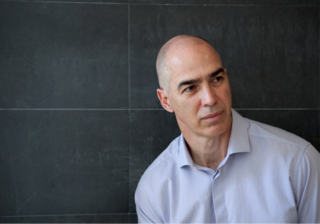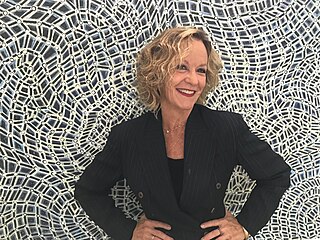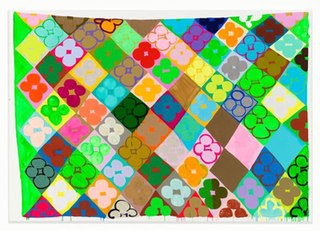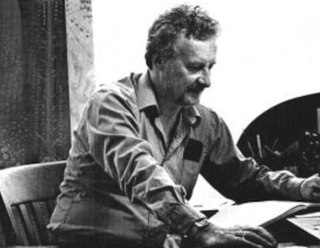Visual arts of Chicago refers to paintings, prints, illustrations, textile art, sculpture, ceramics and other visual artworks produced in Chicago or by people with a connection to Chicago. Since World War II, Chicago visual art has had a strong individualistic streak, little influenced by outside fashions. "One of the unique characteristics of Chicago," said Pennsylvania Academy of Fine Arts curator Bob Cozzolino, "is there's always been a very pronounced effort to not be derivative, to not follow the status quo." The Chicago art world has been described as having "a stubborn sense ... of tolerant pluralism." However, Chicago's art scene is "critically neglected." Critic Andrew Patner has said, "Chicago's commitment to figurative painting, dating back to the post-War period, has often put it at odds with New York critics and dealers." It is argued that Chicago art is rarely found in Chicago museums; some of the most remarkable Chicago artworks are found in other cities.
Gladys M. Nilsson is an American artist, and one of the original Hairy Who Chicago Imagists, a group of representational artists active during the 1960s and 1970s. She is married to fellow-artist and Hairy Who member Jim Nutt.

Eleanor Spiess-Ferris is an American symbolist painter cited as a significant surrealist, narrative figurative and feminist artist. Her numerous visual works display powerful influences of the Spanish and Native American cultures of Northern New Mexico, where she grew up. They often reference Penitentes, retablos, Kachinas and Native American fetishes and frequently incorporate themes of feminist spirituality, Indo-European mythology and personal memory.

Phyllis Bramson is an American artist, based in Chicago and known for "richly ornamental, excessive and decadent" paintings described as walking a tightrope between "edginess and eroticism." She combines eclectic influences, such as kitsch culture, Rococo art and Orientalism, in juxtapositions of fantastical figures, decorative patterns and objects, and pastoral landscapes that affirm the pleasures and follies of romantic desire, imagination and looking. Bramson shares tendencies with the Chicago Imagists and broader Chicago tradition of surreal representation in her use of expressionist figuration, vernacular culture, bright color, and sexual imagery. Curator Lynne Warren wrote of her 30-year retrospective at the Chicago Cultural Center, "Bramson passionately paints from her center, so uniquely shaped in her formative years […] her lovely colors, fluttery, vignette compositions, and flowery and cartoony imagery create works that are really like no one else's. Writer Miranda McClintic said that Bramson's works "incorporate the passionate complexity of eastern mythology, the sexual innuendos of soap operas and sometimes the happy endings of cartoons." Bramson's work has been exhibited in exhibitions and surveys at the Museum of Contemporary Art, Chicago (MCA), the Art Institute of Chicago, the Smithsonian Institution, and Corcoran Gallery of Art. In more than forty one-person exhibitions, she has shown at the New Museum, Fort Wayne Museum of Art, Boulder Art Museum, University of West Virginia Museum, and numerous galleries. She has been widely reviewed and recognized with John S. Guggenheim and Rockefeller foundation grants and the Anonymous Was A Woman Award, among others. She was one of the founding members of the early women's art collaborative Artemisia Gallery and a long-time professor at the School of Art and Design at the University of Illinois at Chicago, until retiring in 2007.

Melissa Miller is an American painter who is best known for what Art in America called "raucous allegorical paintings" of animals that balance storytelling, psychological insight and behavioral observation with technical virtuosity and formal rigor. She rose to prominence during a rebirth in figurative painting and narrative content in the early 1980s championed by curators such as Marcia Tucker and Barbara Rose, who both selected Miller for prominent surveys. Rose identified Miller among a group of iconoclastic "rule breakers," describing her work as "a wild kingdom … gone slightly berserk" in the struggle for survival, whose intensity recalled Delacroix. In a later Artforum review, Donald Kuspit called Miller's paintings "apocalyptic allegories" executed with meticulous old-master methods that articulated psychic states, existential problems and ecological concerns. Miller has exhibited at museums throughout the United States, including the Whitney Museum, New Museum, San Francisco Museum of Modern Art (SFMOMA), Museum of Fine Arts, Houston, and Hirshhorn Museum. Her work belongs to the public art collections of the Museum of Modern Art, National Museum of Women in the Arts, Albright-Knox Gallery and Museum of Fine Arts, Houston, among others, and she has received the Anonymous Was A Woman Award and Texas Artist of the Year Award. Miller lives and works in Austin, Texas.

David Klamen is an American artist and academic. He is known for visually diverse paintings that meld technical mastery with postmodern explorations of the processes by which humans understand and interpret experience. Klamen has exhibited across the United States, Europe and Asia, including individual shows at the Museum of Contemporary Art Chicago (MCA), the Chazen Museum of Art and the Cedar Rapids Museum of Art, and major group exhibitions at the Metropolitan Museum of Art, the Art Institute of Chicago, the Museum of Contemporary Art, San Diego, the Indianapolis Museum of Art, and the Crocker Art Museum. His work sits in the permanent collections of the Metropolitan Museum of Art, the Los Angeles Museum of Contemporary Art and the Whitney Museum of American Art, among others. Klamen has been based in Chicago for most of his career, which includes being an educator for over thirty years, primarily at Indiana University Northwest, where he was appointed Founding Dean, School of the Arts in 2018.
Michiko Itatani is a Chicago-based artist who was born in Osaka, Japan. After she received her BFA (1974) and MFA (1976) at the School of the Art Institute of Chicago in 1974 and 1976 respectively, she returned to her alma mater in 1979 to teach in the Painting and Drawing department. Through her work, Itatani explores identity, continuation, and finding one's way in the modern world. Her work depicts nude figures in an expressionist style. Itatani has received the Illinois Arts Council Artist's Fellowship, the National Endowment for the Arts Fellowship and the John Simon Guggenheim Fellowship. Her work is collected in many museums, including the Museum of Contemporary Art, Olympic Museum, Switzerland; Villa Haiss Museum, Germany; Musée national des beaux-arts du Québec, Canada; Museu D'art Contemporani (MACBA), Spain; and the National Museum of Contemporary Art, South Korea.

JoAnne Carson is an American artist who is known for over-the-top, hybrid works in painting, sculpture and assemblage that freely mix fantasy, illusion and narrative, high and low cultural allusions, and seriocomic intent. She first gained widespread attention in the 1980s for what ARTnews critic Dan Cameron described as "extraordinary painted constructions—kaleidoscopic assemblages chock full of trompe-l’oeil painting, art-history quips, found objects and nostalgic echoes of early modernism." New York Times critic Roberta Smith wrote that Carson's subsequent work progressed methodically into three dimensions, culminating in freestanding botanical sculpture that exuded "giddy beauty" and "unapologetic decorativeness"; her later imaginary landscapes have been described as whimsical spectacles of "Disneyesque horror." Carson has been recognized with a Guggenheim Fellowship, awards from the American Academy of Arts and Letters, American Academy in Rome and National Endowment for the Arts, and Yaddo artist residencies. Her work has been exhibited at institutions including the Whitney Museum of American Art, Museum of Contemporary Art Chicago (MCA), Albright-Knox Gallery, New Orleans Museum of Art, and Institute of Contemporary Art, Philadelphia; it belongs to the public art collections of the Brooklyn Museum of Art, MCA Chicago, Frederick R. Weisman Art Foundation, and Modern Art Museum of Fort Worth, among others.

Andrene Kauffman was an American painter and educator who created a mural for the post office mural project in Ida Grove, Iowa. She completed twenty-five murals and seven sculptures throughout Chicago, as part of the art projects for the New Deal's Section of Painting and Sculpture. Later, she completed seventeen ceramic murals for the 3rd Unitarian Church, which was designated as a Chicago Landmark in 1960. In addition to her artwork and exhibitions, Kauffman taught art for forty-one years at various universities in Chicago, Rockford, Illinois, and Valparaiso, Indiana.

Corey Postiglione is an American artist, art critic and educator. He is a member of the American Abstract Artists in New York, and known for precise, often minimalist work that "both spans and explores the collective passage from modernism to postmodernism" in contemporary art practice and theory. New Art Examiner co-founder Jane Allen, writing in 1976, described him as "an important influence on the development of contemporary Chicago abstraction." In 2008, Chicago Tribuneart critic Alan G. Artner wrote "Postiglione has created a strong, consistent body of work that developed in cycles, now edging closer to representation, now moving further away, but remaining rigorous in approach to form as well as seductive in markmaking and color."
Barbara Sykes into a family of artists, designers and inventors. Since childhood, she has produced work in a variety of different art forms. In 1974, she became one of Chicago’s pioneering video and new media artists and, later to include, independent video producer, exhibition curator and teacher. Sykes is a Chicago based experimental video artist who explores themes of spirituality, ritual and indigeneity from a feminist perspective. Sykes is known for her pioneering experimentation with computer graphics in her video work, utilizing the Electronic Visualization Laboratory at the University of Illinois, Chicago, at a time when this technology was just emerging. Her early works broke new grounds in Chicago’s emerging New Media Art scene, and continue to inspire women to explore experimental realms. With a passion for community, she fostered significant collaborations with many institutions that include but are not limited to University of Illinois, School of the Art Institute of Chicago, Columbia College, Center for New Television, and (art)n laboratory. These collaborations became exemplary for the showcasing of new media work. The wave of video, new media and computer art that she pioneered alongside many other seminal early Chicago New Media artists persists as a major influence for artists and educators today. Her work has been exhibited internationally, at institutions such as Moderna Museet (Stockholm), Ny Carlsberg Glyptotek (Copenhagen), Musée d'Art Moderne de la Ville de Paris, Museum of Contemporary Art San Diego, Metropolitan Museum of Art , Museum of the Art Institute (Chicago), The Metropolitan Museum of Art and SIGGRAPH. Sykes’s tapes have been broadcast in Sweden, Italy, Puerto Rico and extensively throughout in the USA, including “The Independents,” PBS national broadcast, 1985, and national cablecast, 1984. Media Burn has a selection of her tapes online and over 200 of her raw footage, master edits, dubs and compilation tapes in their archives. Select grants include a National Endowment for the Arts and American Film Institute Regional Fellowship, Evanston Art Council Cultural Arts Fund and several Illinois Arts Council grants.
Jan Cicero Gallery was a contemporary art gallery founded and directed by Jan Cicero, which operated from 1974 to 2003, with locations in Evanston and Chicago, Illinois and Telluride, Colorado. The gallery was noted for its early, exclusive focus on Chicago abstract artists at a time when they were largely neglected, its role in introducing Native American artists to mainstream art venues beyond the Southwest, and its showcasing of late-career and young women artists. The gallery focused on painting, and to a lesser degree, works on paper, often running counter to the city's prevailing art currents. It was also notable as a pioneer of two burgeoning Chicago gallery districts, the West Hubbard Street alternative corridor of the 1970s, and the River North district in the 1980s.

Susan Sensemann is an American artist, educator and arts administrator, best known for her detailed, largely abstract patterned paintings and photomontages reflecting gothic, baroque, spiritual and feminist sensibilities. She has exhibited her work at venues including the Art Institute of Chicago, A.I.R., The Living Art Museum (Reykjavík), Indianapolis Art Center, Chicago Cultural Center, and Art Institute of Boston, on four continents. Her work has been widely reviewed and resides in numerous private, university and corporate collections. Sensemann is known as a versatile and prolific creator, whose ideas have led her to explore diverse painting materials, media, subject matter, and styles from abstraction to realism. Critics note her work's densely packed compositions, shallow fields of oscillating space, complex tactile surfaces, and sensuous color and linearity. James Yood wrote that Sensemann's abstract paintings were "fraught with meaning, charged with value, and seething with import" in their spiritual seeking. Art historian Leisa Rundquist described her photomontage self-portraits as "strangely sensual, yet disturbing" images drawn from "the depths of the unconscious."

Laurie Fendrich is an American artist, writer and educator based in New York City, best known for geometric abstract paintings that balance playfulness and sophistication. Her work has been featured in solo exhibitions in New York, Los Angeles and Chicago, a retrospective at the Williamson Gallery at Scripps College (2010), and group shows at MoMA PS1, the Los Angeles County Museum of Art, and the National Academy of Design, among many venues. She has received reviews in publications including The New York Times, Artforum, Art in America, Arts Magazine, ARTnewsPartisan Review, and New York Magazine. Fendrich has been awarded fellowships from the Guggenheim Foundation (2016), Brown Foundation at the Museum of Fine Arts, Houston, and National Endowment for the Arts (1983–4). She has been an educator for more than four decades, notably at Hofstra University (1989–2014), and a regular essayist for The Chronicle Review at The Chronicle of Higher Education.

Eleanor Gorecki Himmelfarb was an American artist, teacher and conservationist known for semi-abstract paintings that reference the landscape and human figure, and for her work protecting woodlands in DuPage County, Illinois. She studied art history and design at the University of Chicago, natural history at the Morton Arboretum, and fine art at the Art Institute of Chicago and University of Illinois at Chicago. Critics characterize Himmelfarb as a modernist, who explored her subjects metaphorically through complex rhythmic compositions, stylized forms, and subtle coloration. Her work was featured in solo shows at the Evanston Art Center (retrospective), University Club of Chicago and Sioux City Art Center, and group exhibitions at the Art Institute of Chicago, Chicago Cultural Center, and Renaissance Society. Himmelfarb taught painting and design for four decades at several institutions, including over 30 years at the DuPage Art League. She was married to the painter, Sam Himmelfarb, and helped him design their house, the Samuel and Eleanor Himmelfarb Home and Studio in Winfield, Illinois, which is listed on the National Register of Historic Places. Their son, John Himmelfarb, and grandchild, Serena Aurora, are also artists. Himmelfarb died at age 98 in Winfield in 2009.

Helen O'Toole is an Irish-born painter based in the United States, who is known for abstract paintings suggestive of landscape. She has exhibited throughout Ireland and the United States, in Singapore, and at venues including the San Francisco Museum of Modern Art, Portland Art Museum, Chicago Cultural Center, Tacoma Art Museum, and Institute of Contemporary Arts Singapore. Her work has been featured in the journals Artforum, Arts Magazine, New Art Examiner, and Zyzzyva, as well as the Chicago Tribune,The Irish Times, Seattle Post-Intelligencer, and National Public Radio. Art writers frequently discuss the interplay in her work between abstraction, the evocation of otherworldly light, land and space, and a commitment to investigating meaning through a painting process akin to the processes of cultivation and excavation. Artforum critic James Yood wrote, "echoing the often inchoate quality of nature, her paint surges toward mystery and hints at a kind of chiaroscuro of the spirit"; curator Bonnie Laing-Malcomson suggests her "richly colored monumental paintings evoke the moody landscape of her rural Irish homeland, summoning the force of J. M. W. Turner and Mark Rothko." She has been recognized with a Guggenheim Fellowship in Fine Arts, a Contemporary Northwest Art Award, and a Pollock-Krasner Foundation Award (2013), among other awards. O'Toole lives in Seattle, Washington and is Professor of Art and Chair of the Painting and Drawing Program at the University of Washington.

Frank Piatek is an American artist, known for abstract, illusionistic paintings of tubular forms and three-dimensional works exploring spirituality, cultural memory and the creative process. Piatek emerged in the mid-1960s, among a group of Chicago artists exploring various types of organic abstraction that shared qualities with the Chicago Imagists; his work, however relies more on suggestion than expressionistic representation. In Art in Chicago 1945-1995, the Museum of Contemporary Art, Chicago (MCA) described Piatek as playing “a crucial role in the development and refinement of abstract painting in Chicago" with carefully rendered, biomorphic compositions that illustrate the dialectical relationship between Chicago's idiosyncratic abstract and figurative styles. Piatek's work has been exhibited at institutions including the Whitney Museum, Art Institute of Chicago, MCA Chicago, National Museum, Szczecin in Poland, and Terra Museum of American Art; it belongs to the public art collections of the Art Institute of Chicago and MCA Chicago, among others. Curator Lynne Warren describes Piatek as "the quintessential Chicago artist—a highly individualistic, introspective outsider" who has developed a "unique and deeply felt world view from an artistically isolated vantage point." Piatek lives and works in Chicago with his wife, painter and SAIC professor Judith Geichman, and has taught at the School of the Art Institute of Chicago since 1974.

Judy Ledgerwood is an American abstract painter and educator, who has been based in Chicago. Her work confronts fundamental, historical and contemporary issues in abstract painting within a largely high-modernist vocabulary that she often complicates and subverts. Ledgerwood stages traditionally feminine-coded elements—cosmetic and décor-related colors, references to ornamental and craft traditions—on a scale associated with so-called "heroic" abstraction; critics suggest her work enacts an upending or "domestication" of modernist male authority that opens the tradition to allusions to female sexuality, design, glamour and pop culture. Critic John Yau writes, "In Ledgerwood’s paintings the viewer encounters elements of humor, instances of surprise, celebrations of female sexuality, forms of vulgar tactility, and intense and unpredictable combinations of color. There is nothing formulaic about her approach."
Joan Livingstone is an American contemporary artist, educator, curator, and author based in Chicago. She creates sculptural objects, installations, prints, and collages that reference the human body and bodily experience.

Richard Loving (1924–2021) was an American artist and educator, primarily based in Chicago, Illinois. He gained recognition in the 1980s as a member of the "Allusive Abstractionists," an informal group of Chicago painters, whose individual forms of organic abstraction embraced evocative imagery and metaphor, counter to the dominant minimalist mode. He is most known for paintings that critics describe as metaphysical and visionary, which move fluidly between abstraction and representation, personalized symbolism taking organic and geometric forms, and chaos and order. They are often characterized by bright patterns of dotted lines and dashes, enigmatic spatial fields, and an illuminated quality. In 2010, critic James Yood wrote that Loving's work "mull[ed] over the possibilities of pattern and representation, of narrative and allegory" to attain a kind of wisdom, transcendence and acknowledgement of universals, "seeking understanding of self within the poetics of the physical world."

















